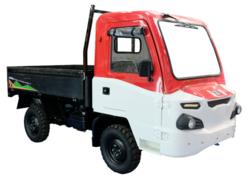Finance:Rural car (Indonesia)

The rural car (Indonesian: mobil pedesaan), also known as the village car (mobil desa), is a grouping of cars commonly found in Indonesia.
The rural car appeared after the second reshuffle of the Joko Widodo's cabinet in July 2016. The reshuffle replaced by the Minister of Industry to Airlangga Hartarto where President Jokowi gave the mandate to develop the Small Medium Enterprises (SMEs) project and rural cars.[1]
This program was initiated by the Ministry of Industry together with the Indonesian Automotive Institute (IOI).[2] The fixed price for a rural car is around Rp60–80 million, cheaper than Kendaraan Bermotor Roda Empat Hemat Energi dan Harga Terjangkau (also called KBH2 or LCGC).[3] Rural cars can only be used on off-road roads and village roads outside the toll road.[4]
These rural vehicles are designed to facilitate community activities in the area with their function as a means of transporting agricultural and plantation products.[5]
Specifications
Ministry of Industry stipulates that cars that can be classified as rural cars are those that meet the following specifications:[1][2]
- The form does not intersect with the vehicle of that era. Assuming dimensions of length × width × height (3.2 m × 1.5 m × 1.8 m plus trailer).
- Vehicle configuration can be 4×4 or 4×2.
- Diesel engine with a capacity of 1,000 cc, can be powered by biofuel (biodiesel).
- Vehicle speed of 50 km/hour.
- The selling price is around Rp60 million on the road.
- Vehicles with simple maintenance concepts and systems.
- The design or shape of the body and cabin has a characteristic or patterned local wisdom.
- The vehicle platform uses frames that are simple and easily assembled.
- The body and cabin are easy to disassemble and with local materials, that must be lightweight and strong.
- Minimum ground clearance of 200 mm.
- In general, this vehicle is easily assembled.
- The vehicle shape design must be multipurpose (for agriculture, plantations, animal husbandry, irrigation, fisheries, fishermen, etc.).
- As a means of transporting people and goods.
See also
References
- ↑ 1.0 1.1 MR, Harryt (9 March 2017). "Definisi mobil pedesaan" (in id). https://otomotifnet.gridoto.com/read/231139565/apa-sih-definisi-mobil-pedesaan-baca-13-kriteria-berikut-ini.
- ↑ 2.0 2.1 Andika, M. Luthfi. "Arti Kendaraan Pedesaan Buat Kemenperin" (in id-ID). https://oto.detik.com/mobil/d-3443787/arti-kendaraan-pedesaan-buat-kemenperin.
- ↑ Ant (6 December 2017). "Libatkan 6 Kementerian, Mobil Pedesaan Dijual Rp60 Juta - Rp80 Juta". https://economy.okezone.com/read/2017/12/06/320/1826071/libatkan-6-kementerian-mobil-pedesaan-dijual-rp60-juta-rp80-juta.
- ↑ "Kemenperin Rampungkan Konsep Mobil Pedesaan, Industri Dipacu Produksi". 1 September 2017. https://kemenperin.go.id/artikel/18096/Kemenperin-Rampungkan-Konsep-Mobil-Pedesaan,-Industri-Dipacu-Produksi.
- ↑ "Kemenperin: Mobil Pedesaan Mudahkan Aktivitas 'Pak Tani'". 3 February 2017. https://kemenperin.go.id/artikel/16957/Kemenperin:-Mobil-Pedesaan-Mudahkan-Aktivitas-%E2%80%98Pak-Tani%E2%80%99.
External links
 |

